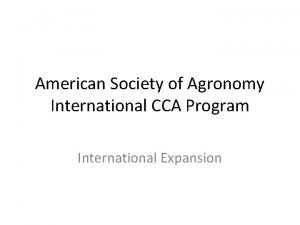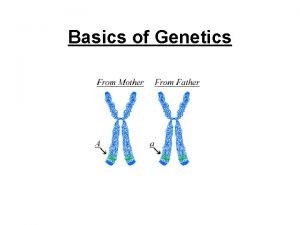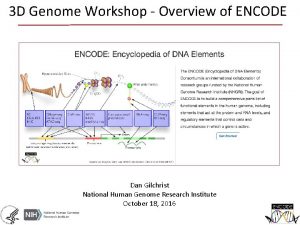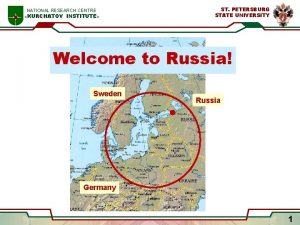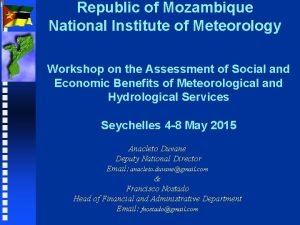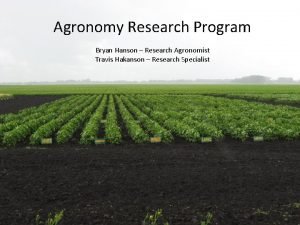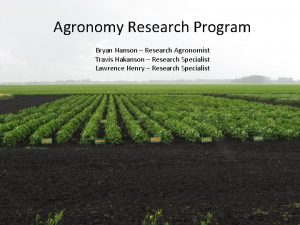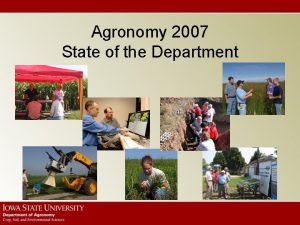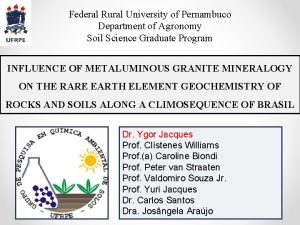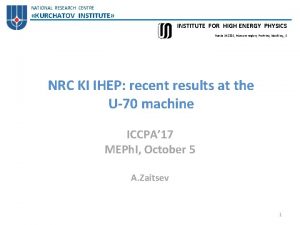National Institute for Agronomy research Department of Agronomy








![Results: Adjusting LAI dynamics model Retrieving MODLAI parameters [LAImax, Ti, DTs, a, b] for Results: Adjusting LAI dynamics model Retrieving MODLAI parameters [LAImax, Ti, DTs, a, b] for](https://slidetodoc.com/presentation_image_h/024b97f02c810f74a5bc5a4c3ce2ba1b/image-9.jpg)


- Slides: 11

National Institute for Agronomy research Department of Agronomy and Environment Bucharest, Fundulea, Romania Toulouse, France A Bottom-up Approach to Characterize Crop Functioning From VEGETATION Time series F. Oro. (1), F. Baret (1), C. Lauvernet (1), R. Vintila (2), N. Rochdi (1) H. de Boissezon (3) (1) INRA, CSE, Avignon, France (2) ICPA, Bucarest, Romania (3) CNES, Toulouse, France foro@avignon. inra. fr Antwerp march 24 -26 2004 1

Introduction Context Yield estimation/forecasting at regional/national/continental/global scales is required for improved security and market management. Users are governments, FAO, NGOs, traders… This question is part of GMES issues The monitoring of crops at these scales is currently only accessible operationally from large swath sensors such as VEGETATION that provides enough revisit frequency Problem: Difficulty to monitor each individual crop because of mixed pixels HRV VGT 1 km Antwerp march 24 -26 2004 2

Objective To develop and evaluate a method to estimate crop production with SPOT/VEGETATION data Approach: forcing a crop growth model with LAI dynamics derived from remote sensing: allow to integrate soil & climate available information within the growth model Cultural practices LAI dynamics Stics SPOT VEGETATION Meteorological data Soil characteristics Production How to derive LAI dynamics of specific crops from VEGETATION time series? ? ? Antwerp march 24 -26 2004 3

A bottom-up approach to retrieve LAI dynamics Simulated Actual VEGETATION time series Comparison AGREGATION Ajusting parameters ri(t) Ci Classification SPOT/HRV 20 x 20 m² RT model LAIi(t) [LAImax, Ti, DTs, a, b] MODLAI parameters Antwerp march 24 -26 2004 MODLAI Measured Temperatures 4

Detailed objectives of the study evaluate the approach in two steps: 1 - develop the approach based on simulations using a series of SPOT/HRV images -Define the LAI dynamics models for different covers -Get prior information on the distribution of the parameters -Evaluate RT models for reflectance simulation -and to investigate the sources of uncertainties 2 - Evaluate the approach over actual VEGETATION data The study is based on the ADAM experiment Antwerp march 24 -26 2004 5

The ADAM experiment www. medias. obs-mip. fr/adam Fundulea Other 12% Alfalfa 6% Pea Romania • 8% Water 2% Forest 4% Focus on wheat crops Maize 36% Wheat 32% 10 Km x 10 Km The data collected in 2000 -2001 Satellite data Meteo/atmosphere Vegetation variables Soil variables 39 SPOT/HRV images 16 ERS/Radarsat VEGETATION data Temperature Radiation Rainfall … Aerosol Opt. Thick. LAI Biomass & distribution Chlorophyll Moisture Texture Organic matter Moisture profiles Bulk density Chemistry … Antwerp march 24 -26 2004 Yield 6

Results: Temporal profiles of reflectances of each cover Extraction of 100 pixels for each cover class in the red and near infrared bands Maize Alfalfa Pea Water Forest Wheat Antwerp march 24 -26 2004 7

Results: Deriving LAI temporal profiles Inversion of RT model (SAIL+PROSPECT) over the 100 pixels Inverting RT model (SAIL+PROSPECT) to get canopy variables Example of the wheat crop LAI Leaf angle Hot-spot Leaf dry matter Antwerp march 24 -26 2004 Leaf structure Soil brightness Chlorophyll Good consistency of Consistent Canopy Retrieved variables variable retrievals 8
![Results Adjusting LAI dynamics model Retrieving MODLAI parameters LAImax Ti DTs a b for Results: Adjusting LAI dynamics model Retrieving MODLAI parameters [LAImax, Ti, DTs, a, b] for](https://slidetodoc.com/presentation_image_h/024b97f02c810f74a5bc5a4c3ce2ba1b/image-9.jpg)
Results: Adjusting LAI dynamics model Retrieving MODLAI parameters [LAImax, Ti, DTs, a, b] for the 100 pixels and each class Example of the wheat crop Ti, DTs: Significant dates of the life cycle of cultures a, b: rate of growth and senescence Good description of the Dynamics of LAI values LAImax a Ti Antwerp march 24 -26 2004 D Ts b 9

Results: prior distribution of MODLAI parameters Computation of the distribution of the MODLAI parameters: It will constitute the prior distribution used in the bottom-up approach LAImax DTs b Ti Antwerp march 24 -26 2004 Good consistency of the distribution of parameters 10

CONCLUSION Interest of the proposed bottom-up approach: • Innovative approach to combine - few high spatial resolution images (land cover classification) - with high temporal frequency medium resolution temporal series • Less dependant on scaling Potential problems • Variability within one cover class? But using mixed models would allow to account for • Impact of the performances of the models used ? : MODLAI and RT models? • Effect of the VEGETATION registration? apply the approach to resolution larger than 1 km? Status of the study • The study is still under development… next steps: • Adjusting the MODLAI parameters to complete the bottom-up loop • Evaluate the sources of uncertainties: registration, variability within cover class, … • Apply the approach to actual VEGETATION data and evaluate the performances • Compare the performances of this bottom up approach with top-down approaches (desagregation) • Force the 24 -26 STICS growth model to evaluate the performances of yield estimation Antwerp march 2004 11
 American society of agronomy cca
American society of agronomy cca Assistive technology implementation plan sample
Assistive technology implementation plan sample National human genome research institute
National human genome research institute National human genome research institute
National human genome research institute Codom
Codom National human genome research institute
National human genome research institute National research institute of brewing
National research institute of brewing Swedish national road and transport research institute
Swedish national road and transport research institute National research center kurchatov institute
National research center kurchatov institute National research center kurchatov institute
National research center kurchatov institute Ulsan national institute of science and technology
Ulsan national institute of science and technology National institute of meteorology
National institute of meteorology
